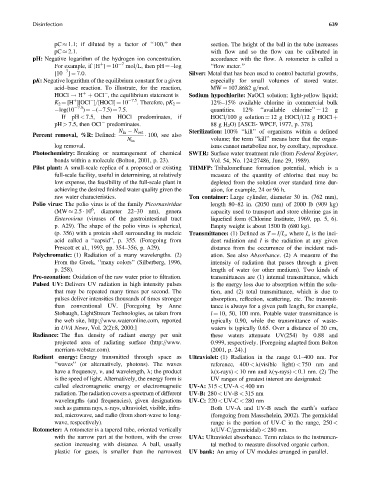Page 684 - Fundamentals of Water Treatment Unit Processes : Physical, Chemical, and Biological
P. 684
Disinfection 639
pC 1.1; if diluted by a factor of ‘‘100,’’ then section. The height of the ball in the tube increases
pC 2.1. with flow and so the flow can be calibrated in
pH: Negative logarithm of the hydrogen ion concentration. accordance with the flow. A rotometer is called a
For example, if [H ] ¼ 10 7 mol=L, then pH ¼ –log ‘‘flow meter.’’
þ
7
[10 ] ¼ 7.0. Silver: Metal that has been used to control bacterial growths,
pK: Negative logarithm of the equilibrium constant for a given especially for small volumes of stored water.
acid–base reaction. To illustrate, for the reaction, MW ¼ 107.8682 g=mol.
HOCl ! H þ OCl , the equilibrium statement is Sodium hypochlorite: NaOCl solution; light-yellow liquid;
þ
7.5
K 2 ¼ [H ][OCl ]=[HOCl] ¼ 10 . Therefore, pK 2 ¼ 12%–15% available chlorine in commercial bulk
þ
log(10 7.5 )¼ ( 7.5)¼ 7.5. quantities. 12% ‘‘available chlorine’’ ¼ 12 g
If pH < 7.5, then HOCl predominates, if HOCl=100 g solution ¼ 12 g HOCl=(12 g HOCl þ
pH > 7.5, then OCl predominates. 88 g H 2 O) [ASCE- WPCF, 1977, p. 378].
N in N out Sterilization: 100% ‘‘kill’’ of organisms within a defined
Percent removal, %R: Defined: 100, see also
N in volume; the term ‘‘kill’’ means here that the organ-
log removal. isms cannot metabolize nor, by corollary, reproduce.
Photochemistry: Breaking or rearrangement of chemical SWTR: Surface water treatment rule (from Federal Register,
bonds within a molecule (Bolton, 2001, p. 23). Vol. 54, No. 124:27486, June 29, 1989).
Pilot plant: A small-scale replica of a proposed or existing THMFP: Trihalomethane formation potential, which is a
full-scale facility, useful in determining, at relatively measure of the quantity of chlorine that may be
low expense, the feasibility of the full-scale plant in depleted from the solution over standard time dur-
achieving the desired finished water quality given the ation, for example, 24 or 96 h.
raw water characteristics. Ton container: Large cylinder, diameter 30 in. (762 mm),
Polio virus: The polio virus is of the family Picornaviridae length 80–82 in. (2050 mm) of 2000 lb (909 kg)
6
(MW 2.5 10 , diameter 22–30 nm), genera capacity used to transport and store chlorine gas in
Enterovirus (viruses of the gastrointestinal tract liquefied form (Chlorine Institute, 1969, pp. 5, 6).
p. A29). The shape of the polio virus is spherical, Empty weight is about 1500 lb (680 kg).
(p. 356) with a protein shell surrounding its nucleic Transmittance: (1) Defined as T ¼ I=I o , where I o is the inci-
acid called a ‘‘capsid’’, p. 355. (Foregoing from dent radiation and I is the radiation at any given
Prescott et al., 1993, pp. 354–356, p. A29). distance from the occurrence of the incident radi-
Polychromatic: (1) Radiation of a many wavelengths. (2) ation. See also Absorbance. (2) A measure of the
From the Greek, ‘‘many colors’’ (Silberberg, 1996, intensity of radiation that passes through a given
p. 258). length of water (or other medium). Two kinds of
Pre-ozonation: Oxidation of the raw water prior to filtration. transmittances are (1) internal transmittance, which
Pulsed UV: Delivers UV radiation in high intensity pulses is the energy loss due to absorption within the solu-
that may be repeated many times per second. The tion, and (2) total transmittance, which is due to
pulses deliver intensities thousands of times stronger absorption, reflection, scattering, etc. The transmit-
than conventional UV. [Foregoing by Anne tance is always for a given path length, for example,
Stobaugh, LightStream Technologies, as taken from l ¼ 10, 50, 100 mm. Potable water transmittance is
the web site, http:==www.wateronline.com, reported typically 0.90, while the transmittance of waste-
in UVA News, Vol. 2(2):8, 2000.] waters is typically 0.65. Over a distance of 20 cm,
Radiance: The flux density of radiant energy per unit these waters attenuate UV(254) by 0.88 and
projected area of radiating surface (http:==www. 0.999, respectively. [Foregoing adapted from Bolton
merriam-webster.com). (2001, p. 24).]
Radiant energy: Energy transmitted through space as Ultraviolet: (1) Radiation in the range 0.1–400 nm. For
‘‘waves’’ (or alternatively, photons). The waves reference, 400 < l(visible light) < 750 nm and
have a frequency, n, and wavelength, l; the product l(x-rays) < 10 nm and l(g-rays) < 0.1 nm. (2) The
is the speed of light. Alternatively, the energy form is UV ranges of greatest interest are designated:
called electromagnetic energy or electromagnetic UV-A: 315 < UV-A < 400 nm
radiation. The radiation covers a spectrum of different UV-B: 280 < UV-B < 315 nm
wavelengths (and frequencies), given designations UV-C: 220 < UV-C < 280 nm
such as gamma rays, x-rays, ultraviolet, visible, infra- Both UV-A and UV-B reach the earth’s surface
red, microwave, and radio (from short-wave to long- (foregoing from Masschelein, 2002). The germicidal
wave, respectively). range is the portion of UV-C in the range, 250 <
Rotometer: A rotometer is a tapered tube, oriented vertically l(UV-C=germicidal) < 280 nm.
with the narrow part at the bottom, with the cross UVA: Ultraviolet absorbance. Term relates to the instrumen-
section increasing with distance. A ball, usually tal method to measure dissolved organic carbon.
plastic for gases, is smaller than the narrowest UV bank: An array of UV modules arranged in parallel.

